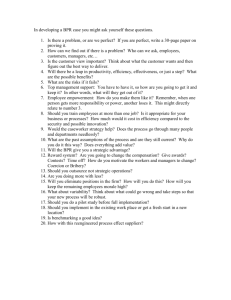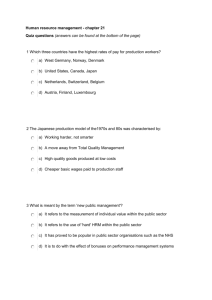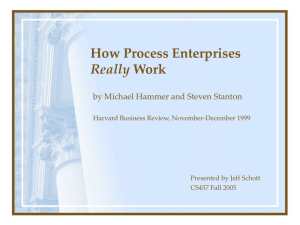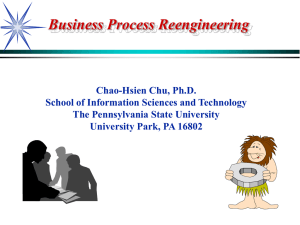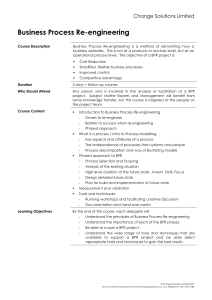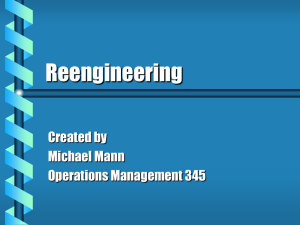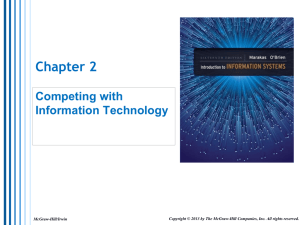BPR
advertisement
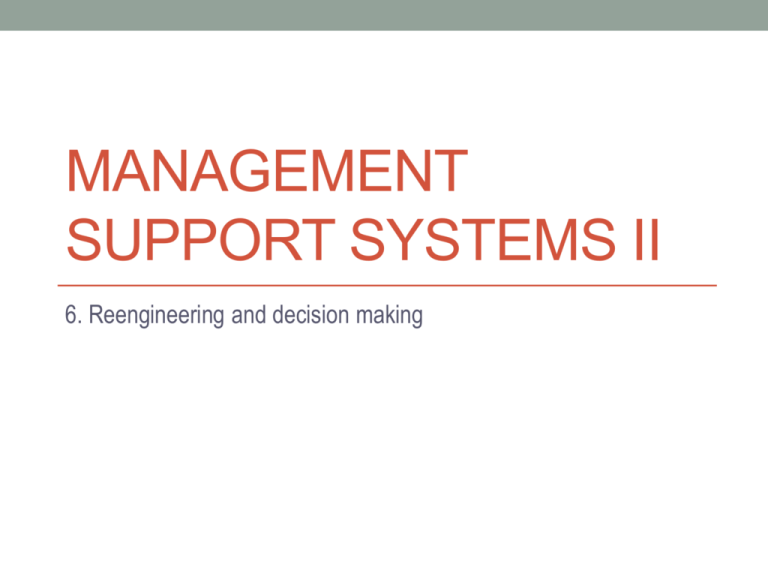
MANAGEMENT SUPPORT SYSTEMS II 6. Reengineering and decision making What is BPR? • Reengineering is the fundamental rethinking and redesign of business processes to achieve dramatic improvements in critical, contemporary measures of performance, such as cost, quality, service and speed. (Hammer & Champy, 1993) Reengineering Defined • Reengineering is defined as the fundamental rethinking and radical redesign of business processes to achieve dramatic improvements in critical, contemporary measures of performance such as cost, quality, service, and speed. As a engineering discipline, reengineering can be applied to any process in manufacturing and service businesses, education, and the government. • Business process reengineering (BPR) is focused on reengineering business processes. Key Words in the Reengineering Definition • Fundamental • Why do we do what we do • Ignore what is and concentrate on what should be • Radical • Business reinvention vs. business improvement • Dramatic • Reengineering should be brought in “when a need exits for heavy blasting” • • • Companies in deep trouble Companies that see trouble coming Companies that are in peak condition • Business Process • a collection of activities that takes one or more kinds of inputs and creates an output that is of value to a customer Principles of Reengineering • Organize around outcomes, not tasks • Have those who use the output of the process perform the process • Merge information-processing work into the real work that produces the information • Treat geographically dispersed resources as though they were centralized • Link parallel activities instead of integrating their results • Put the decision point where the work is performed, and build control into the process • Capture information once and at the source NO savings come from installing new software or hardware – only from implementing, using, and supporting improved processes and their enablers, to give you the management info you need to make cost-saving decisions BPR example 1 BPR example 1 BPR example 2 BPR example 2 BPR example 2 BPR example 3 • Example: IBM Credit • Credit approval process required six days before Business Process Reengineering (see Fig 5-12) BPR example 3 • After Business Reprocess Engineering, IBM was able to process 100 times the number of transactions in the same amount of time BPR Versus Process Simplification Process Simplification Process Reengineering Incremental Change Process-Led Assume Attitudes & Behaviors Management-Led Various Simultaneous Projects Radical Transformation Vision-Led Change Attitudes & Behaviors Director-Led Limited Number of Initiatives (Source Coulson-Thomas, 1992) BPR Versus Continuous Improvement Continuous Improvement Process Reengineering Incremental Change People Focus Low Investment Improve Existing Work Unit Driven Radical Transformation People & Technology Focus High Investment Rebuild Champion Driven Select the Process & Appoint Process Team • Two Crucial Tasks • Select The Process to be Reengineered • Appoint the Process Team to Lead the Reengineering Initiative Select the Process • Review Business Strategy and Customer Requirements • Select Core Processes • Understand Customer Needs • Don’t Assume Anything • Select Correct Path for Change • Remember Assumptions can Hide Failures • Competition and Choice to Go Elsewhere • Ask - Questionnaires, Meetings, Focus Groups Appoint the Process Team • Appoint BPR Champion • Identify Process Owners • Establish Executive Improvement Team • Provide Training to Executive Team Core Skills Required • Capacity to view the organization as a whole • Ability to focus on end-customers • Ability to challenge fundamental assumptions • Courage to deliver and venture into unknown areas • Ability to assume individual and collective responsibility • Employ ‘Bridge Builders’ Use of Consultants • Used to generate internal capacity • Appropriate when a implementation is needed quickly • Ensure that adequate consultation is sought from staff so that the initiative is organization-led and not consultantdriven • Control should never be handed over to the consultant Understand the Current Process • Develop a Process Overview • Clearly define the process • Mission • Scope • Boundaries • Set business and customer measurements • Understand customers expectations from the process (staff including process team) Understand the Current Process • Clearly Identify Improvement Opportunities • Quality • Rework • Document the Process • Cost • Time • Value Data • Carefully resolve any inconsistencies • Existing -- New Process • Ideal -- Realistic Process Develop & Communicate Vision of Improved Process • Communicate with all employees so that they are aware of the vision of the future • Always provide information on the progress of the BPR initiative - good and bad. • Demonstrate assurance that the BPR initiative is both necessary and properly managed Develop & Communicate Vision of Improved Process • Promote individual development by indicating options that are available • Indicate actions required and those responsible • Tackle any actions that need resolution • Direct communication to reinforce new patterns of desired behavior Identify Action Plan • Develop an Improvement Plan • Appoint Process Owners • Simplify the Process to Reduce Process Time • Remove any Bureaucracy that may hinder implementation • Remove no-value-added activities • Standardize Process and Automate Where Possible • Up-grade Equipment • Plan/schedule the changes • Construct in-house metrics and targets • Introduce and firmly establish a feedback system • Audit, Audit, Audit Execute Plan • Qualify/certify the process • Perform periodic qualification reviews • Define and eliminate process problems • Evaluate the change impact on the business and on customers • Benchmark the process • Provide advanced team training Benefits From IT • Assists the Implementation of Business Processes • Enables Product & Service Innovations • Improve Operational Efficiency • Coordinate Vendors & Customers in the Process Chain Common Problems • Process Simplification is Common - True BPR is Not • Desire to Change Not Strong Enough • Start Point the Existing Process Not a Blank Slate • Commitment to Existing Processes Too Strong • REMEMBER - “If it ain’t broke …” • Quick Fix Approach Common Problems with BPR • Process under review too big or too small • Reliance on existing process too strong • The Costs of the Change Seem Too Large • BPR Isolated Activity not Aligned to the Business Objectives • Allocation of Resources • Poor Timing and Planning • Keeping the Team and Organization on Target Risks of Radical Redesign • Difficult to manage the process. • Manager needs a strong set of skills. • Insuring acceptance of the new process. • Transformation champion needed. • Clear and well thought out plan. • Risk of failure of the new process. Summary • Reengineering is a fundamental rethinking and redesign of business processes to achieve dramatic improvements • BPR has emerged from key management traditions such as scientific management and systems thinking • Rules and symbols play an integral part of all BPR initiatives • Don’t assume anything - remember BPR is fundamental rethinking of business processes

